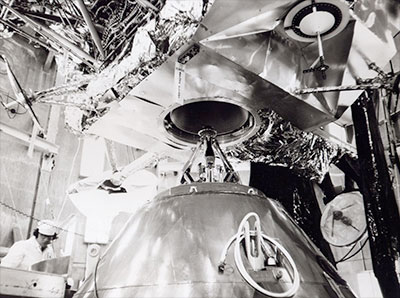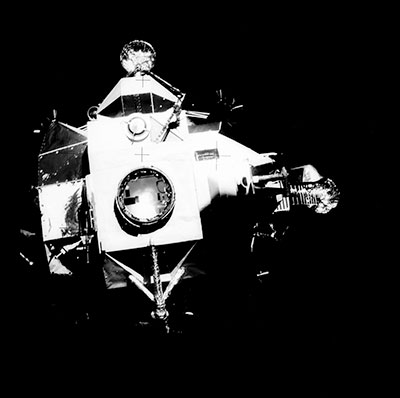|
Author
|
Topic: Failure of Apollo LM to undock from CSM
|
Paul78zephyr
Member Posts: 716
From: Hudson, MA
Registered: Jul 2005
|
 posted 05-04-2021 04:14 PM
posted 05-04-2021 04:14 PM
  
Apollo 15 had a issue where the lunar module failed to undock from the command and service modules due to a loose umbilical in the docking tunnel. This was easily corrected but I would like to know what contingencies there were if a LM and CSM could not be undocked due to a hard failure of the docking/capture mechanism? |
Paul78zephyr
Member Posts: 716
From: Hudson, MA
Registered: Jul 2005
|
 posted 05-04-2021 05:07 PM
posted 05-04-2021 05:07 PM
  
In answering my own question: the LM would be jettisoned using a pyrotechnic (explosive) device. |
oly
Member Posts: 1216
From: Perth, Western Australia
Registered: Apr 2015
|
 posted 05-04-2021 06:58 PM
posted 05-04-2021 06:58 PM
   
The Apollo docking ring was mounted to the command module for the majority of the mission, It has capture latches mounted circumferentially, and the docking probe was installed inside the docking ring.This image, via the Honeysuckle Creek, shows the ring attached to the CM, and details of the LM section in the normal configuration.  This image, via NASA, of the Apollo 13 Lunar module taken after LM jettison, shows the docking ring with capture latches now attached to the LM.  The latches can be seen around the inner circumference of the docking ring. |
Paul78zephyr
Member Posts: 716
From: Hudson, MA
Registered: Jul 2005
|
 posted 05-04-2021 10:02 PM
posted 05-04-2021 10:02 PM
  
Thanks for the pics! Do you know if when the LM was jettisoned using the pyrotechnic device if that alone was enough to cause the LM to deorbit the moon or did they have to command the LM to use its thrusters? |
Jim Behling
Member Posts: 1637
From: Cape Canaveral, FL
Registered: Mar 2010
|
 posted 05-07-2021 08:12 AM
posted 05-07-2021 08:12 AM
   
Thrusters were needed. |
Robsch
New Member Posts: 8
From:
Registered: Feb 2018
|
 posted 05-11-2021 04:31 PM
posted 05-11-2021 04:31 PM
  
Was the need for this backup separation process the primary reason fot using pyrotechnics to do the final undocking? |
oly
Member Posts: 1216
From: Perth, Western Australia
Registered: Apr 2015
|
 posted 05-12-2021 02:11 AM
posted 05-12-2021 02:11 AM
   
When the LM and CSM dock, the docking probe and drogue latch together via the capture latches, and the probe retracts, drawing the to modules together. The docking latches clamp the two vehicles together, creating an airtight seal. The probe and drogue can be removed and stowed to facilitate crew movement between the two vehicles via the tunnel. To undock the two vehicles, the probe and drogue are reinstalled, and the probe is pre-loaded to allow the docking latches to be opened. The probe is then extended, gently pushing the LM away from the CSM. When the lunar landing has been achieved, the same docking technique is used. At the end of mission for the LM, the probe and drogue are stowed in the LM, no longer required, and now excess mass. As the docking probe can no longer be pre-loaded to unload the docking latches, unlatching the docking latches requires the CM catch to be sealed and the tunnel depressurised. If for any reason the latches don’t release, the hatch would have to be removed, requiring the crew to don full pressure suit and helmet, depressurise the CM, remove the hatch, and manually unlatch the docking latches. (all while the vehicle is hurtling towards Earth). Docking and undocking using the docking probe can only be achieved a limited number of times due to the use of pressurised nitrogen stored in 4 small gas bottles inside the probe assembly. As a sure-fire method of achieving the same thing in a timelier manner, the whole docking ring is cut free. |
Robsch
New Member Posts: 8
From:
Registered: Feb 2018
|
 posted 05-13-2021 05:40 PM
posted 05-13-2021 05:40 PM
  
Thanks for the explanation, makes sense now (apart from the ‘hurtling towards earth’ part. I’m pretty sure the undocking took place in lunar orbit. |
oly
Member Posts: 1216
From: Perth, Western Australia
Registered: Apr 2015
|
 posted 05-13-2021 08:03 PM
posted 05-13-2021 08:03 PM
   
I was referencing the Apollo 13 image above, where the Earth was getting very big in the window. |
Robsch
New Member Posts: 8
From:
Registered: Feb 2018
|
 posted 05-14-2021 02:33 AM
posted 05-14-2021 02:33 AM
  
Ahh, of course. |













